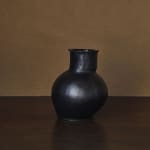Yagi Kazuo (1918–1979)
Black Pottery Vase
Stoneware
With a box signed by the artist
W16.5 x H20.5 cm
With a box signed by the artist
W16.5 x H20.5 cm
Further images
Yagi Kazuo began to first experiment with his black pottery when he was looking for ways to prevent his earthenwares’ glaze from turning cloudy. The inorganic texture that Yagi aimed for can be perceived in this vase as well. By using this approach, the artist eventually succeeded in eliminating much of the accidentality that occurs during the firing process in a kiln. Moreover, Yagi also wanted to move counter the popular trend of irregular, accidental shapes, hence from the outset he would try to introduce some sense of regularity in terms of form, an aspect that is also apparent in the present work. Here, he offsets the neck from the vertical axis and slightly shifts the horizontal center of gravity of the body. The negotiation of regularity and irregularity in the body clearly reveals Yagi’s distinctive attitude towards form. Notably, the part of the neck where it transitions to the shoulder of the vessel has an inward bulge on the one side, while on the other it continues without such disturbance of contour. This, of course, is also a formal detail that Yagi consciously created.
The concept of the black pottery objet grew on Yagi when he worked on two identically titled pieces, Black Pottery (1958) and Black Pottery (1957–60), both now in the collection of the Kyoto Municipal Museum of Art. In 1960–63, Yagi would experiment with irregular forms as when creating Portrait: Wind Vase, a vase based on a double-layered basic form where one side appeared as if erased and replaced by a deep cavity.
At first, Yagi applied the term black pottery not just to his objets but used it as an expression of his strict rejection of any traditional approach in ceramics. Therefore, it could be used for all his non-functional vessels. The present vase likely is one of the early pieces among Yagi’s black pottery objets. Still, it is difficult to delineate separate phases in the artist’s career, not the least because his extant output from these years remains small. When Yagi made Mr. Samsa Walking in 1954, he used slices of cyclindrical shapes thrown on a potter’s wheel. The potter’s wheel has traditionally been regarded as an organic extension of the potter’s mind and body, yet by the mid-1950s Yagi had begun to downgrade its subjective importance to being merely one among a whole set of tools and techniques at his disposal. His production of black pottery peaked after 1957, therefore this vase should be regarded as a transitional piece. In other words, it provides a link from his early work the fully-developed black pottery phase.
Yagi Kazuo (ceramist; 1918–1979)
Ceramist from Kyoto. As a co-founder of Sodei-sha (Crawling through Mud Association), Yagi was largely responsible for establishing and popularizing non-functional objects as a major category of postwar Japanese ceramic art. Working in Shigaraki clay for much of his career, Yagi later turned to “black pottery” (kokuto). He taught at the Kyoto City University of the Arts.
The concept of the black pottery objet grew on Yagi when he worked on two identically titled pieces, Black Pottery (1958) and Black Pottery (1957–60), both now in the collection of the Kyoto Municipal Museum of Art. In 1960–63, Yagi would experiment with irregular forms as when creating Portrait: Wind Vase, a vase based on a double-layered basic form where one side appeared as if erased and replaced by a deep cavity.
At first, Yagi applied the term black pottery not just to his objets but used it as an expression of his strict rejection of any traditional approach in ceramics. Therefore, it could be used for all his non-functional vessels. The present vase likely is one of the early pieces among Yagi’s black pottery objets. Still, it is difficult to delineate separate phases in the artist’s career, not the least because his extant output from these years remains small. When Yagi made Mr. Samsa Walking in 1954, he used slices of cyclindrical shapes thrown on a potter’s wheel. The potter’s wheel has traditionally been regarded as an organic extension of the potter’s mind and body, yet by the mid-1950s Yagi had begun to downgrade its subjective importance to being merely one among a whole set of tools and techniques at his disposal. His production of black pottery peaked after 1957, therefore this vase should be regarded as a transitional piece. In other words, it provides a link from his early work the fully-developed black pottery phase.
Yagi Kazuo (ceramist; 1918–1979)
Ceramist from Kyoto. As a co-founder of Sodei-sha (Crawling through Mud Association), Yagi was largely responsible for establishing and popularizing non-functional objects as a major category of postwar Japanese ceramic art. Working in Shigaraki clay for much of his career, Yagi later turned to “black pottery” (kokuto). He taught at the Kyoto City University of the Arts.







